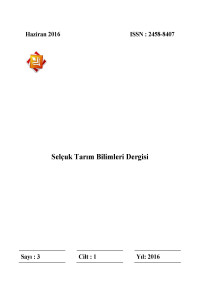The Effect of Plant Diversity on the Presence of Arbuscular Mycorrhizal Fungi Spores in the Same Soil Series
Abstract
Different arbuscular mycorrhizal fungus (AMF) species can adapt to a wide variety of soil characteristics and the presence of a wide variety of hosts. AMF spores can even adapt to poor environmental conditions and reproduce by means of certain mechanisms they develop. In addition, the presence of different plant species is largely responsible for the presence of different AMF spore species. Mycorrhizal (dependent on mycorrhiza) and nonmycorrhizal (nondependent on mycorrhiza) status of plants, which they form depending on the affinity of plants for mycorrhizae, has a guiding effect on some of their mechanisms. This case affects the increase or decrease of the mycorrhizal spore presence in the soil. Within the scope of the aim of the present study, soil sampling (0-20 cm) was performed from areas cultivated with wheat and sugar beet, which are plants from two different families (Gramineae and Amaranthaceae). The sampling areas were in the Alibey Series of Çumra Plain in Konya Closed Basin. In the collected soil samples, (AMF) spore counts were performed and their distributions depending on plant type were determined. In the present study conducted in the Alibey Series of Çumra Plain, the number of mycorrhizal spores isolated from the areas cultivated with wheat, which is a mycorrhizal plant, was determined as 35-259 spores/10 g soil, whereas this number was found to be 17.19-146,19 spores/10 g soil in the same amount of soil isolated from the areas cultivated with nonmycorrhizal sugar beet plant. The difference between the means of the mycorrhizal spore numbers counted through isolating from wheat and sugar beet cultivated soils was found
to be statistically significant (P<0.01).
Abstract
Arbusküler mikorizal fungus (AMF) türleri çok geniş toprak özellikleri ve konukçu varlığına adaptasyon gösterebilirler. AMF sporları kötü çevre koşullarına bile geliştirdikleri birtakım mekanizmalar vasıtası ile adapte olabilmekte ve çoğalabilmektedirler. Bunun yanı sıra farklı AMF spor türlerinin varlığından farklı bitki türlerinin varlığı da geniş ölçüde sorumludur. Bitkilerin mikorizalar ile afinitesine bağlı olarak oluşturdukları mikorizal (mikorizaya bağımlı) ya da nonmikorizal (mikorizaya bağımlı olmayan) olma durumları, onların bazı mekanizmaları üzerine yönlendirici etki yapmaktadır. Bu durum ise topraktaki mikorizal spor varlığının artış ya da azalışı üzerine etki eder. Bu çalışmanın amacı kapsamında Konya Büyük Kapalı Havzası, Çumra Ovası’na ait Alibey Serisi’nde iki farklı familyanın (Gramineae ve Amaranthaceae) bitkileri olan buğday ve şeker pancarı ekili alanlardan toprak örneklemesi (0-20 cm) yapılmıştır. Alınan toprak örneklerinde (AMF) spor sayımları yapılarak, bitki çeşidine göre dağılım durumları belirlenmiştir. Yapılan bu çalışmada Çumra Ovası Alibey Serisi’nde mikorizal bir bitki olan buğday ekili alanlardan alınan toprak örneklerinde mikoriza spor sayısı 35-259 adet/10 g toprak olarak belirlenirken, non-mikorizal bir bitki olan şeker pancarı ekili alanlardan alınan toprak örneklerinde bu sayı 17.19-146,19 adet/10 g toprak olarak belirlenmiştir. Buğday ve şeker pancarı toprağında belirlenen mikoriza spor sayılarının ortalamaları arasındaki fark istatistiksel olarak önemli (P<0.01) bulunmuştur.
Details
| Primary Language | English |
|---|---|
| Subjects | Soil Sciences and Ecology |
| Journal Section | Research Article |
| Authors | |
| Publication Date | June 25, 2016 |
| Submission Date | February 25, 2016 |
| Published in Issue | Year 2016 Volume: 3 Issue: 1 |
Selcuk Agricultural and Food Sciences is licensed under a Creative Commons Attribution-NonCommercial 4.0 International License (CC BY NC).


